|
|
|
Sort Order |
|
|
|
Items / Page
|
|
|
|
|
|
|
| Srl | Item |
| 1 |
ID:
164072
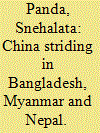

|
|
|
|
|
| Summary/Abstract |
China has pulled into its orbit relatively poor South Asian countries like Bangladesh, Myanmar and Nepal by extensive economic support and investments in infrastructure development. Bangladesh and Myanmar are important for accessing strategically located ports which will provide it alternative sea routes for unimpeded trade and commerce. Nepal is important to tighten its border with Tibet. Moreover, it is a cleverly planned strategy to access their market, supply military equipment and eclipse India’s influence in these countries. But it is no cakewalk as big international powers are countering China through diplomatic and economic means to constrict its growing influence in South Asia. The local communities are averse to its aid and investment as they apprehend that the projects are intended to benefit the investor and endanger their livelihood as well as environment while governments in each of these countries are striving to balance their relationship with big powers.
|
|
|
|
|
|
|
|
|
|
|
|
|
|
|
|
| 2 |
ID:
155245
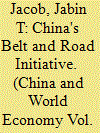

|
|
|
|
|
| Summary/Abstract |
China's Belt and Road Initiative (BRI) is often simplistically understood as being opposed by India and supported by Pakistan. The reality on the ground is rather more complex. The emerging consensus in India appears to be that, far from being exclusively an economic and infrastructure development program, the BRI may be understood as a long-term strategic initiative that seeks to convert China's current economic might into diplomatic influence. While attempts have been made by Beijing, the reflexive Indian suspicion of Chinese international projection, including of China's BRI, has not yet been met by a coherent discourse designed to specifically address Indian concerns. In contrast, in Pakistan, widespread acceptance of the importance and necessity of the China–Pakistan Economic Corridor is increasingly coupled with concerns within sectors of Pakistani society over the fairness, transparency and eventual economic outcomes of the project. Accordingly, this paper is divided into two parts: the first looks at how Indian analysts have viewed and responded to the Chinese discourse and arguments on the BRI; the second considers the debate over the China–Pakistan Economic Corridor within Pakistan.
|
|
|
|
|
|
|
|
|
|
|
|
|
|
|
|
| 3 |
ID:
119369
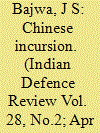

|
|
|
| 4 |
ID:
162733
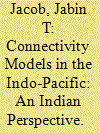

|
|
|
|
|
| Summary/Abstract |
China’s Belt and Road Initiative (BRI) is often sold as a project that aims to meet the infrastructure deficit in many underdeveloped parts of the world. However, Chinese projects under the BRI come with features that have negative short-term and long-term implications for the host countries in question. Chinese project financing almost uniformly lacks transparency, including about the terms of this financing, and is accompanied by uncertainty about local benefits such as employment and by poor standards. This paper begins by highlighting some key features of Chinese infrastructure projects under the BRI, before it examines, in detail, the financing of these projects, particularly in South Asia. The article concludes by stating that China’s success in pushing the BRI – despite its several problems – is the result of the inability of democratic nations to come up with feasible alternatives that respect local sensitivities and conditions in the countries in need of infrastructure development. India, especially, has much to reflect upon in respect of its own methods and approaches towards its neighbours and towards overseas development assistance in the wake of China’s BRI.
|
|
|
|
|
|
|
|
|
|
|
|
|
|
|
|
| 5 |
ID:
092821


|
|
|
|
|
| Publication |
2009.
|
| Summary/Abstract |
This paper summarized a development history and lessons of Korean nuclear power infrastructures from the beginning of the nuclear power program in 1956 to the localization of complete scope of PWR technology in 1990. The objective of this paper is to show the guideline on the issues that the development of a national infrastructure for nuclear power using the realistic experiences in order to help the developing countries newly starting nuclear power program as a long-term energy supply option. Development strategies and lessons learned from the successful Korean experience have been presented based on milestones structure of IAEA in order to help decision makers, advisers, senior managers and national planners of nuclear power program. Lessons for national nuclear power programs include considerations before launching a program, preparation and decision making, and the construction of the first nuclear power plant. Scope of these lessons includes knowledge and human resources management, financial and industrial infrastructure development, nuclear safety, legislative and regulatory experiences, fuel cycle and waste management, international cooperation. Fourteen lessons learned either positive or not are derived from the Korean case and are suggested for incorporation in the IAEA's efforts in support of developing countries' development of nuclear infrastructure and planning.
|
|
|
|
|
|
|
|
|
|
|
|
|
|
|
|
| 6 |
ID:
167095
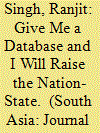

|
|
|
|
|
| Summary/Abstract |
This paper draws on an ethnographic study of Aadhaar, India’s biometrics-based national identification infrastructure, to investigate how members of its design team conceptualised and understood their techno-bureaucratic enterprise of assigning unique numbers to Indian residents. Members described their work using the metaphor of building an hour-glass: the Aadhaar number and its authentication services constitute the waist of this hour-glass; below were innovations in biometric devices and above were applications requiring identity verification services. They believed the entire ecosystem sustaining Aadhaar could be controlled by prescribing interactions between the waist and the components above and below. They extended this metaphor to reimagine the Indian government as a platform of services controlling only a specific part of a service—the waist—while opening space for innovation by integrating it with other market services above and below. This paper documents the emergence of this imaginary of ‘platformised’ government collecting real-time citizen data to support personalised state–citizen interactions to unpack how the future(s) of Indian government services shapes and is shaped by it. Such future(s) constitute the Indian population as a database, bureaucracies as centralised dashboards, and government as arbiter in the circulation of citizen data.
|
|
|
|
|
|
|
|
|
|
|
|
|
|
|
|
| 7 |
ID:
133856


|
|
|
|
|
| Publication |
2014.
|
| Summary/Abstract |
Construction of a high-speed railway linking Europe, Asia, Africa and North and South America is a serious proposal that will profoundly impact international relations. Discussion of the internationalization of high-speed rail transportation is being led from the advanced position of China's well regarded achievements in this field. Global geopolitics and traditional geopolitics theories will also undergo revolutionary changes as cooperative planning proceeds.
|
|
|
|
|
|
|
|
|
|
|
|
|
|
|
|
| 8 |
ID:
124540
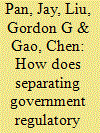

|
|
|
|
|
| Publication |
2013.
|
| Summary/Abstract |
This paper evaluates the effect of regulatory reform separating the operational control and regulatory oversight of public hospitals in China. Using city-level data and a difference-in-difference (DID) model, this paper estimates the changes in healthcare supply in response to the regulatory reform. Based on the DID estimates, in Weifang between 2006 and 2008, the reform led to a 39.3% increase in the number of doctors per 10,000 residents and 40.1% increase in the number of health workers per 10,000 residents. Similarly, in Suzhou between 2005 and 2008 the reform led to increases of 60.5%, 30.8% and 36.6% for hospital beds, doctors and health workers per 10,000 people, respectively. Moreover, the magnitude of this impact appears to increase over time. Furthermore, the effect of the reform is consistent regardless of whether the separation reform takes place inside or outside the government. These findings lead us to conclude that the government should focus only on the regulation of healthcare markets, while leaving hospital operation to the free market.
|
|
|
|
|
|
|
|
|
|
|
|
|
|
|
|
| 9 |
ID:
168305


|
|
|
|
|
| Summary/Abstract |
This paper examines transitioning to low carbon vehicles such as battery electric vehicles (BEVs), hydrogen fuel cell vehicles (FCVs), and natural gas vehicles (NGVs) for curbing greenhouse gas (GHG) emissions in Japan. Infrastructure development for fuel charging stations for BEVs, FCVs and NGVs and the carbon tax are evaluated as policy measures to promote these vehicle fleets as well as the reduction in the life cycle GHG emissions. Our analysis uses the newly developed Japanese multi-regional partial equilibrium system dynamics model UniSyD_JP. The energy supply sector consists of fossil fuels, nuclear energy, renewable energy and hydrogen and the nation's energy demand is projected by the expected population growth and the GDP outlook. The energy demand for the transport sector is endogenously determined by a consumer's vehicle choice characterized by the multinomial logit model. We examine five scenarios for different mixes of infrastructure development, carbon tax and projected oil price. The transition paths to a low carbon vehicle fleet are explored for the period of 2016–2060. We found that infrastructure development increases the penetration of FCVs and NGVs, but it will not reduce the life cycle GHG emissions. Significant emissions reduction requires both infrastructure development and high carbon taxes.
|
|
|
|
|
|
|
|
|
|
|
|
|
|
|
|
| 10 |
ID:
133572
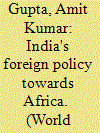

|
|
|
|
|
| Publication |
2014.
|
| Summary/Abstract |
India has been using benign means to develop its relations with Africa based on consultations and cooperation, mediated by an increasingly active diplomacy. Mohammed Badrul Alam and Amit Kumar Gupta aver that in contrast to China's strategy, India has focussed on capacity building rather than infrastructure development.
|
|
|
|
|
|
|
|
|
|
|
|
|
|
|
|
| 11 |
ID:
143078
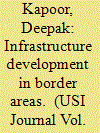

|
|
|
| 12 |
ID:
162534
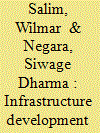

|
|
|
|
|
| Summary/Abstract |
In any emerging nation, efficient infrastructure holds the key to economic and social development. In the case of Indonesia, however, decades of under-investment and poor asset management have left the country with a significant infrastructure deficit. This paper explores the key problems facing infrastructure development in Indonesia since the Yudhoyono era. The current administration aims to tackle this challenge and improve the competitiveness of the Indonesian economy. Compared to the previous administration, the incumbent government has taken a more pragmatic approach to achieve its goals. One major policy has been to shift budget allocations away from fuel subsidies and towards infrastructure development. This has also been accompanied by continued efforts to reform regulatory and institutional frameworks. Despite these measures, the overall progress of Jokowi’s infrastructure development has not been as smooth as expected. Limited resources and capacity mean that the administration needs to re-evaluate the number of national strategic initiatives and be more selective in prioritizing infrastructure projects. Moreover, the national strategic projects must be linked to larger development plans with longer time-frame, such as the National Spatial Plan and sectoral master plans in order to achieve integrated regional development.
|
|
|
|
|
|
|
|
|
|
|
|
|
|
|
|
| 13 |
ID:
128256
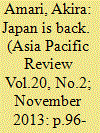

|
|
|
|
|
| Publication |
2013.
|
| Summary/Abstract |
Japan's economy has gone through more than a decade of deflation. Following the inauguration of the Abe Administration in December 2012, "Abenomics" has prioritized exiting deflation, revitalizing the economy and getting Japan back on the road toward fiscal health. This article discusses the efforts to create three virtuous cycles as Japan aims to regain its position as a leader in the global economy and proposes a prescription for resolving common challenges in the future.
|
|
|
|
|
|
|
|
|
|
|
|
|
|
|
|
| 14 |
ID:
153244
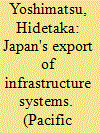

|
|
|
|
|
| Summary/Abstract |
This article focuses on the export of infrastructure systems as Japan's foreign economic policy that is unique in terms of diplomatic goals and means. It seeks to address how and why the Japanese government has strengthened commitments to expanding infrastructure exports to major Asian countries. This article argues that the Japanese government took advantage of developmental means of state-led initiative and institutionalised government-business collaboration in sustaining the export of infrastructure systems. It also contends that the Japanese government pursued, in the infrastructure export initiative, twin goals of creating a new growth engine to revitalise the Japanese economy and strengthening strategic links with Asian countries to balance China's regional influence.
|
|
|
|
|
|
|
|
|
|
|
|
|
|
|
|
| 15 |
ID:
130007
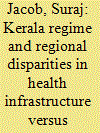

|
|
|
|
|
| Publication |
2014.
|
| Summary/Abstract |
Conventional wisdom holds that although at the time of Kerala state formation in 1956 the northern region (Malabar) lagged behind the southern region (Travancore-Cochin) in development indicators, inter-regional disparities reduced considerably in ensuing decades. The reduction in regional disparities is typically attributed to modern Kerala's welfare policy regime, which emphasized greater growth of infrastructure facilities in Malabar. This study presents evidence for health that suggests that while disparities in outcomes reduced over time, disparities in key infrastructural inputs did not reduce. These differing trends for infrastructure and outcomes are consistentwith a diminishing returns argument that may have little to do directly with the Kerala regime. Rather, the potency of the Kerala regime lays in its ability to increase development inputs throughout the state (albeit without favoring the lagging region) and consolidate the conditions for "public action" to effectively demand and utilize these inputs.
|
|
|
|
|
|
|
|
|
|
|
|
|
|
|
|
| 16 |
ID:
187087


|
|
|
|
|
| Publication |
Ahmedabad, Nanoland Publishers, 2020.
|
| Description |
238p.pbk
|
| Standard Number |
9788193498323
|
|
|
|
|
|
|
|
|
|
|
|
Copies: C:1/I:0,R:0,Q:0
Circulation
| Accession# | Call# | Current Location | Status | Policy | Location |
| 060223 | 338.954/ACH 060223 | Main | On Shelf | General | |
|
|
|
|
| 17 |
ID:
160836


|
|
|
|
|
| Summary/Abstract |
While major arenas of Sino-Japanese struggle are maritime security affairs and political leadership in managing regional affairs, infrastructure development is emerging as a new source of rivalry. Given this new trend, this article highlights rivalry in the provision of regional institutions and programs to sustain infrastructure development and the winning of the Jakarta–Bandung high-speed railway project in Indonesia. It argues that in committing to infrastructure development, China and Japan were required to pay due attention to close connections with existing multilateral development banks and responses to the needs of a target government. Moreover, it contends that both states regarded commitments to infrastructure development as crucial vehicles to enhance political leverage and means to sustain the national economy and diffuse specific ideals for development.
|
|
|
|
|
|
|
|
|
|
|
|
|
|
|
|
| 18 |
ID:
129262


|
|
|
|
|
| Publication |
2012.
|
| Summary/Abstract |
To the Government of the Xinjiang Autonomous Region: The Summary of Discussions on the Work of Opening Up Xinjiang has been perused and approved by Comrade Gu Mu. In line with the opinions of leading comrades, it is hereby printed and issued to you. Please study it and carry it out. Ever since the third plenary session of the eleventh party congress, Xinjiang has been politically stable and united and economic construction has developed rapidly. The industrial and agricultural gross output value of 1986 has more than doubled that of 1980. Agriculture and animal husbandry have had bumper harvests for ten consecutive years, and the region is more than self-sufficient in cereals, cotton, oil, and sugar crops. Import trade, use of foreign currency, and the tourist business have made significant progress. Airline and railway communications and transport conditions have seen constant improvement. Xinjiang has abundant resources and a vast, sparsely populated territory and has great potential for developing the economy and supporting national construction.
|
|
|
|
|
|
|
|
|
|
|
|
|
|
|
|
| 19 |
ID:
086271


|
|
|
|
|
| Publication |
2008.
|
| Summary/Abstract |
The first three press conferences included in this issue pertain to the overall construction projects and that of the competition venues. As a whole, they constitute three temporal markers in the construction projects. The first document is the transcript of the press conference on the progress of the Olympic Games related construction projects scheduled on December 20, 2005. Organized by and held at the Olympic Games Main Press Center, the press conference includes an on-site visit of the National Sports Stadium (Bird's Nest) that followed the presentation and question-and-answer session. The pressconference itself features the minister, the deputy commander, and the chief economist of the Beijing 2008 Olympics Project Construction Headquarters. It covers the constructions of competition and noncompetition venues, training facilities, and urban transportation.
|
|
|
|
|
|
|
|
|
|
|
|
|
|
|
|
| 20 |
ID:
175320
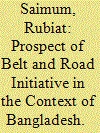

|
|
|
|
|
| Summary/Abstract |
The purpose of this article is to examine the prospect of the Belt and Road Initiative (BRI) from the perspective of Bangladesh. The article investigates fundamental aspects of China’s economic involvement in Bangladesh to understand the geo-economic basis of the initiative. In this respect, the objective and motivation behind Chinese involvement in Bangladesh’s economy are studied, and the political and economic challenges emanating from the participation of the latter country in the initiative are outlined. Methodologically, this research adopts a qualitative approach and relies on primary sources to collect data. It concludes with an observation that Chinese investments through BRI could, in the long term, be advantageous for Bangladesh’s economy as long as the regional and economic issues associated with the initiative are appropriately dealt with. Besides, it suggests that the success of the initiative in South Asia, as well as in Bangladesh, requires a collaborative effort from all the states of the region on functional issue areas such as trade and connectivity.
|
|
|
|
|
|
|
|
|
|
|
|
|
|
|
|
|
|
|
|
|